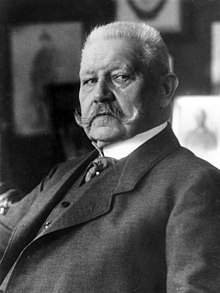 Global Information
Global InformationPaul von Hindenburg information
Generalfeldmarschall Paul von Hindenburg | |
|---|---|
 Official portrait, c. 1919–1928 | |
| President of Germany | |
| In office 12 May 1925 – 2 August 1934 | |
| Chancellor | See list
|
| Preceded by | Friedrich Ebert |
| Succeeded by | Adolf Hitler (as Führer) |
| Chief of the Great General Staff | |
| In office 29 August 1916 – 3 July 1919 | |
| Deputy | Erich Ludendorff (as First Quartermaster-General) |
| Preceded by | Erich von Falkenhayn |
| Succeeded by | Wilhelm Groener |
| Personal details | |
| Born | 2 October 1847 Posen, Kingdom of Prussia |
| Died | 2 August 1934 (aged 86) Neudeck, Nazi Germany |
| Resting place | St. Elizabeth's Church, Marburg |
| Political party | Independent |
| Spouse |
Gertrud von Sperling
(m. 1879; died 1921) |
| Children | 3, including Oskar |
| Relatives | Erich von Manstein (nephew) |
| Signature | |
| Military service | |
| Allegiance |
|
| Branch/service |
|
| Years of service |
|
| Rank | Generalfeldmarschall |
| Battles/wars |
|
| Awards |
|
Paul Ludwig Hans Anton von Beneckendorff und von Hindenburg (pronounced [ˈpaʊl ˈluːtvɪç hans ˈantoːn fɔn ˈbɛnəkn̩dɔʁf ʔʊnt fɔn ˈhɪndn̩bʊʁk] ⓘ; abbreviated pronounced [ˈpaʊl fɔn ˈhɪndn̩bʊʁk] ⓘ; 2 October 1847 – 2 August 1934) was a German field marshal and statesman who led the Imperial German Army during World War I.[1] He later became president of Germany from 1925 until his death.[1] During his presidency, he played a key role in the Nazi seizure of power in January 1933 when, under pressure from his advisers, he appointed Adolf Hitler as chancellor of Germany.[1]
Hindenburg was born to a family of minor Prussian nobility in Posen. Upon completing his education as a cadet, he enlisted in the Third Regiment of Foot Guards as a second lieutenant. He then saw combat during the Austro-Prussian and Franco-Prussian wars. In 1873, he was admitted to the prestigious Kriegsakademie in Berlin, where he studied for three years before being appointed to the Army's General Staff Corps. Later in 1885, he was promoted to the rank of major and became a member of the Great General Staff. After a five-year teaching stint at the Kriegsakademie, Hindenburg steadily rose through the army's ranks to become a lieutenant general by 1900. Around the time of his promotion to General of the Infantry in 1905, Count Alfred von Schlieffen recommended that he succeed him as Chief of the Great General Staff but the post ultimately went to Helmuth von Moltke in January 1906. In 1911, Hindenburg announced his retirement from the military.
After World War I started in July 1914, Hindenburg was recalled to military service and quickly achieved fame on the Eastern Front as the victor of Tannenberg. Subsequently, he oversaw a crushing series of victories against the Russians that made him a national hero and the center of a massive personality cult. By 1916, Hindenburg's popularity had risen to the point that he replaced General Erich von Falkenhayn as Chief of the Great General Staff.[2] Thereafter, he and his deputy, General Erich Ludendorff, exploited Emperor Wilhelm II's broad delegation of power to the German Supreme Army Command to establish a de facto military dictatorship. Under their leadership, Germany secured Russia's defeat in the east and achieved advances on the Western Front deeper than any seen since the conflict's outbreak. However, by the end of 1918, all improvements in Germany's fortunes were reversed after the German Army was decisively defeated in the Second Battle of the Marne and the Allies' Hundred Days Offensive. Upon his country's armistice with the Allies in November 1918, Hindenburg stepped down as Germany's commander-in-chief and retired once again from military service in 1919.
In 1925, Hindenburg returned to public life to become the second elected president of the German Weimar Republic. Personally opposed to Adolf Hitler and his Nazi Party, Hindenburg nonetheless played a major role in the political instability that resulted in their rise to power. After twice dissolving the Reichstag in 1932, Hindenburg agreed in January 1933 to appoint Hitler as chancellor in coalition with the Deutschnationale Volkspartei. In response to the Reichstag fire, which was allegedly committed by Marinus van der Lubbe, he approved the Reichstag Fire Decree in February 1933, which suspended various civil liberties. Later in March, he signed the Enabling Act of 1933, which gave the Nazi regime emergency powers. After Hindenburg died the following year, Hitler combined the presidency with his office as chancellor before proceeding to declare himself Führer und Reichskanzler des deutschen Volkes (lit. 'Leader and Reich Chancellor of the German People') and transformed Germany into a totalitarian state.
- ^ a b c Dorpalen, Andreas (16 February 2024). "Paul von Hindenburg". www.britannica.com. Retrieved 8 March 2023.
- ^ Chisholm, Hugh, ed. (1922). . Encyclopædia Britannica. Vol. 31 (12th ed.). London & New York: The Encyclopædia Britannica Company. pp. 370–371.